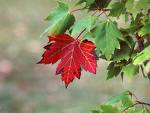 GLEBE TREES AND SHRUBS
GLEBE TREES AND SHRUBS
IDENTIFICATION OF GLEBE TREES AND SHRUBS - by leaf
Traditional classification of leaves
1. Oppositely-arranged, not divided into leaflets, not toothed.
2. Oppositely-arranged, not divided into leaflets, toothed.
3. Oppositely-arranged, divided into leaflets, not toothed.
4. Oppositely-arranged, divided into leaflets, toothed.
5. Alternately-arranged, not divided into leaflets, not toothed.
6. Alternately-arranged, not divided into leaflets, not toothed.
7. Alternately-arranged, not divided into leaflets, not toothed.
8. Alternatly-arranged, not divided into leaflets, not toothed.
9. Differentiating the maples by leaf
10. Needle-leaved trees
1. Leaves oppositely-arranged, not divided into leaflets, not toothed
Beauty bush
Catalpa, Northern
Dogwood, Red osier
Honeysuckle, Tartarian
Lilac
Lilac, Japanese
Mock-orange
Snowberry
2. Same but with teeth
Beauty bush
Buckthorn, European
Forsythia
Maple, Amur
Maple, Japanese
Maple, Manitoba
Maple, Norway
Maple, Norway (crimson king)
Maple, Red
Maple, Silver
Maple, Sugar
Mock-orange
Nannyberry
Wild raisin
3. Leaves oppositely-arranged, divided into leaflets, not toothed
Ash - often do have a few teeth, sometimes none
Maple, Manitoba
4. Same but with teeth
Ash
Clematis
Maple, Manitoba
Trumpet creeper
Elderberry (not seen in the Glebe yet)
5. Leaves alternately-arranged, not divided into leaflets, not toothed
Barberry
Bittersweet
Buckthorn, Glossy
Ginkgo
Ivy, Boston
Magnolia
Mulberry
Oak, Bur
Oak, English
Oak, Pin
Oak, Red
Rhododendron
Smoketree
Tamarisk
Willow
Willow, Weeping
6. Same but with teeth
Barberry
Birch, European
Birch, White
Bittersweet
Buckthorn, European
Cherry, Purpleleaf
Cherry, Purpleleaf (Cis)
Cottonwood, Eastern
Crabapple, flowering
Currant
Currant, Golden
Elm, White
Elm, Siberian
Elm, Slippery
Grape, Riverbank
Hackberry
Hawthorn
Hazel
Ironwood
Ivy, Boston
Linden
Mulberry
Pincherry
Willow
Willow, Weeping
7. Leaves alternately-arranged, divided into leaflets, and not toothed
Honey-locust
Pea tree
Potentilla
8. Same but with teeth
Bramble
Butternut
Honey-locust
Mountain ash
Rose
Spirea, False
Sumac, Staghorn
Virginia creeper
Walnut, black
Wild raisin
Hickory (not identified in the Glebe yet)
9. Differentiating the maples by leaf
10 maples identified in the Glebe: sugar, Norway, crimson king (a Norway maple),
Schwedler (a Norway maple), silver, red, Manitoba, Japanese, Amur, Tatarian.
6 have distinctive leaves, either shape or colour:
Amur maple - small leaves, barely maple-like
Tatarian maple - a type of Amur with leaves that are unlobed or almost so
Japanese maple - very finely cut and burgundy colour
Silver maple - finely cut
Manitoba maple - not maple-like; compound
Crimson king maple - burgundy-coloured Norway maple
Schwedler - burgundy colour at start of season
That leaves only three: Norway, sugar and red.
Red maple Red maple leaves are smaller, often 3-lobed, or approaching 3 lobes, but variable.
Norway maple and Sugar maple, which can be difficult to tell apart.
The definitive test is to break the stem. Norway maple leaves have milky sap.
Norway maple leaves seem often bigger and darker green. They have sharper points,
almost bristled, especially at the base. There are more Norway maple in the Glebe.
That said, there seem to be silver-red maple hybrids.
10. Needle-leaved trees
To be done
Tips
When checking compound leaves for opposite vs alternate arrangement, look at the leaves,
not the leaflets. The leaflets are almost always opposite, regardless.
Lobes are not teeth. Oak have lobes, no teeth. Maple have both.
The leaves of young saplings can fool you. They can be much bigger than usual and even look different.
E-mail error reports.
 GLEBE TREES AND SHRUBS
GLEBE TREES AND SHRUBS GLEBE TREES AND SHRUBS
GLEBE TREES AND SHRUBS